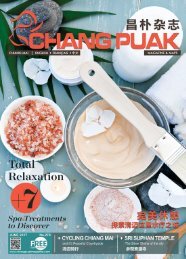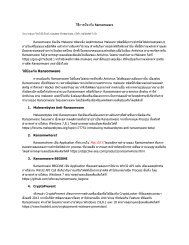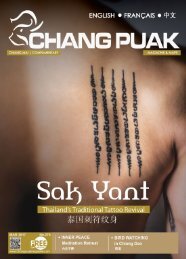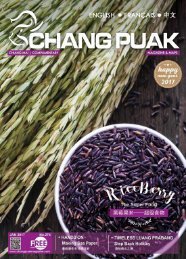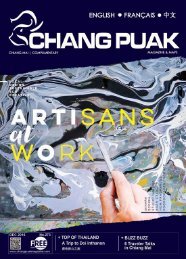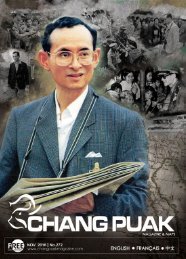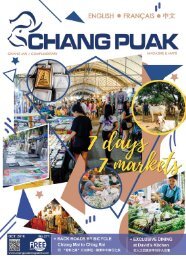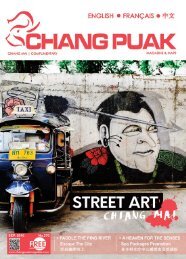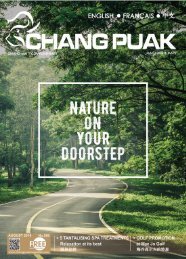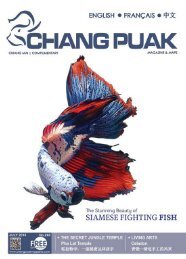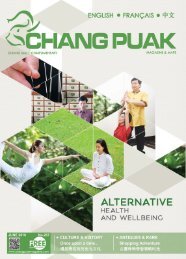You also want an ePaper? Increase the reach of your titles
YUMPU automatically turns print PDFs into web optimized ePapers that Google loves.
during <strong>Songkran</strong> Festival<br />
SONGKRAN,<br />
TRADITIONS & BELIEFS:<br />
F<br />
un is actually just one aspect of Chiang Mai<br />
<strong>Songkran</strong> festival. It actually has a deep meaning<br />
and that is to ask for blessing and to enrich religious<br />
intentions. Traditionally people would use only a light<br />
sprinkling of water to symbolize purification. As everyone<br />
wishes for good vibes, house wives clean their houses. On<br />
the other hand, young individuals are showing their respect<br />
to elders by pouring fragrant water on their palms.<br />
<strong>Songkran</strong> festival in Chiang Mai is divided in three major<br />
days. The first important day is April 13th, which is called<br />
Wan Maha <strong>Songkran</strong>, meaning the day marking the end of<br />
the old year. This day is pretty much a day of preparation:<br />
Thai people go to the market and prepare delicious dishes<br />
for the new year. They also buy equipment for water playing.<br />
April 14th is Wan Nao (Nao Day). This is an auspicious<br />
day when everyone must be cheerful, talk politely and not<br />
behave badly. In the morning, food and offerings for the<br />
monks are prepared and then distributed to friends and<br />
relatives the following morning. In the afternoon, sand is<br />
brought to the temple compounds and sand stupas are made<br />
as a form of worship to the Lord Buddha. Finally the time<br />
comes for gently splashing water at one another with a word<br />
of blessing.<br />
April 15th is Wan Talerng Sok (Talerng Sok day). This day<br />
is the most important day of the New Year celebration, this is<br />
the year when the new year begins.<br />
Important local traditions includes the making of sand<br />
stupas in temples decorated with colorful flags (read our<br />
article pages 22-23) and Lanna drums competitions (read<br />
our article pages 46-47).<br />
Mai Kham Bho offering.<br />
Sand Pagoda<br />
1. Attend Alms Giving, early morning at<br />
Thapae Gate (April 13) :<br />
As the sun rises in Chiang Mai, hundreds<br />
of Buddhist monks depart from their<br />
various temples for Thapae Gate. The<br />
tradition of alms offering dates back to<br />
the 14th century, yet still today locals<br />
wake up early to prepare food for the<br />
monks and wait quietly by the roadside.<br />
This ceremony is both peaceful and<br />
spiritual and it gives you a wonderful<br />
opportunity to experience the real<br />
Thailand.<br />
Everyone is welcome to join this Alms<br />
Giving ceremony, just walk to Thapae<br />
Gate at around 7am.<br />
2. Witness the superb procession of<br />
Phra Phuttha Sihing, a revered<br />
Buddha image of the North:<br />
The image is taken in a procession that<br />
moves from Wat Prasingh and around<br />
Chiang Mai city. You can view the<br />
procession on Ratchadamnoen road,<br />
leading to Wat Prasingh.<br />
3. Enjoy water splashing around the<br />
moat:<br />
Envisage a traffic jam for four days with<br />
people dancing on top of their cars. This<br />
epitomises the spirit of <strong>Songkran</strong>! Part<br />
of the fun of <strong>Songkran</strong> festival is to walk<br />
around the old city’s moat, where most of<br />
the action takes place. Hundreds of cars<br />
join in which creates the city’s biggest<br />
annual traffic jam.<br />
4. Visit Warorot Market:<br />
Warorot Market is the biggest market<br />
in Chiang Mai. Take a few hours to walk<br />
around and enjoy the experience: people<br />
will be wearing traditional Chiang Mai blue<br />
clothes or colorful hawaiin style shirts.<br />
Traditional <strong>Songkran</strong> music will play all day,<br />
putting big smiles on everyone’s faces.<br />
There will also be many delicious dishes for<br />
sale. Don’t miss visiting the left side building<br />
which features more than twenty stands<br />
of traditional <strong>Songkran</strong> accessories such<br />
as flags for sand pagodas, scented water,<br />
Mai Kham Bo wood and flowers.<br />
5. Experience traditions unique to<br />
Chiang Mai such as Mai Kham Bho<br />
Procession and Sand Offering:<br />
The Mai Kham Bho Procession is centered<br />
on the Bho tree, a sacred tree that can<br />
be found in temples (picture page 10). Bho<br />
trees are surrounded by wooden supports<br />
called Mai Kham Bo and these supports<br />
are placed around the trees in temples.<br />
Local beliefs say that the act of placing<br />
support around sacred trees brings luck<br />
and prosperity to devotees. Mai Kam Bho<br />
pr cessions usually fall on the same day<br />
of April as <strong>Songkran</strong>.<br />
Another important custom is to build<br />
sand pagodas in the temples.Vilagers<br />
arrive in their best clothes with candles,<br />
joss sticks, flowers, ceremonial flags and<br />
handfuls of sand.<br />
The sand is used to make miniature<br />
pagodas that are decorated with colorful<br />
flags and sprinkled with scented water.In<br />
local tradition, when people bring sand to<br />
the temple, it is a way to compensate for<br />
any they may have inadvertently carried<br />
away on the bottom of their shoes during<br />
the year.<br />
10 11



